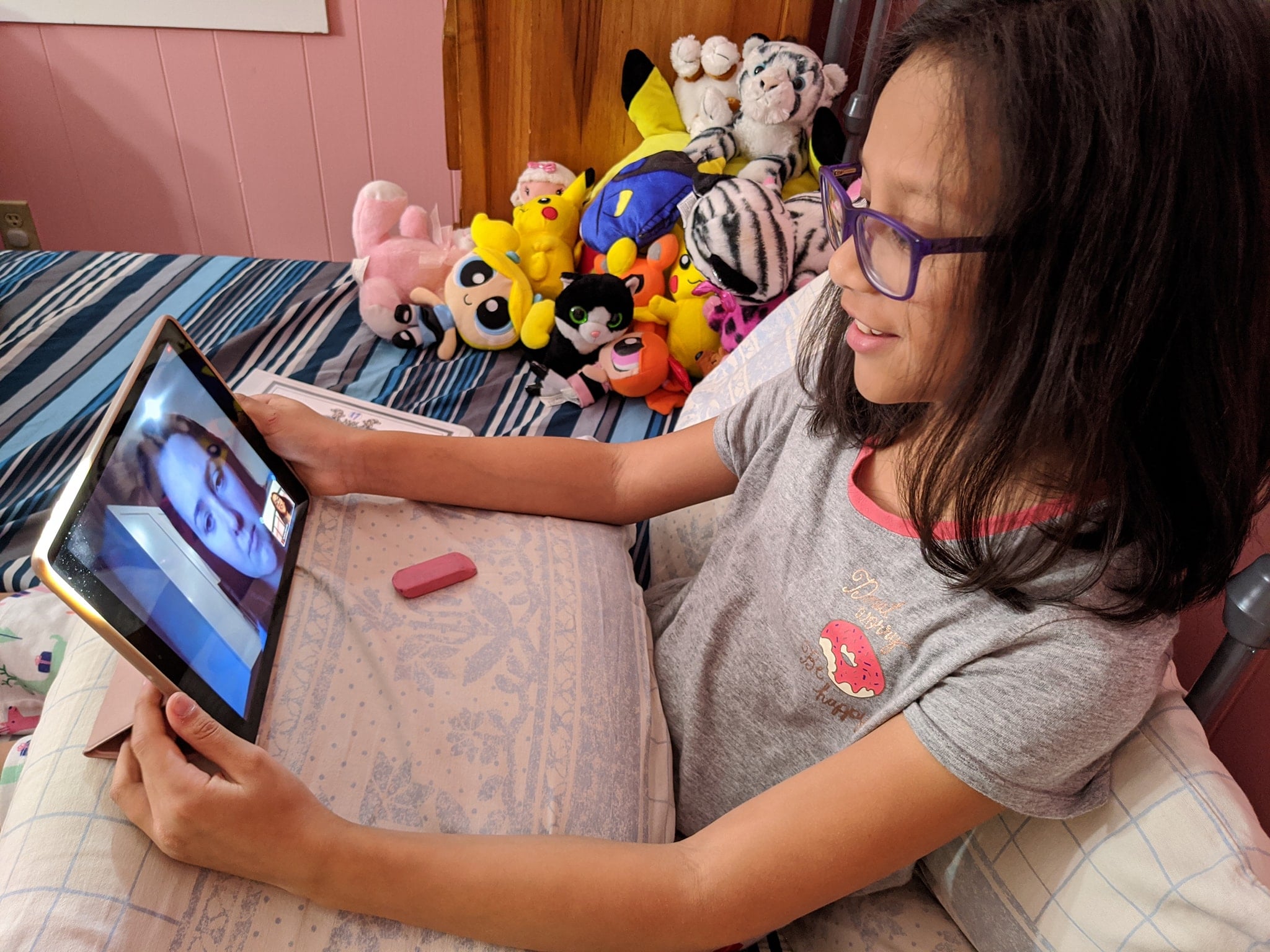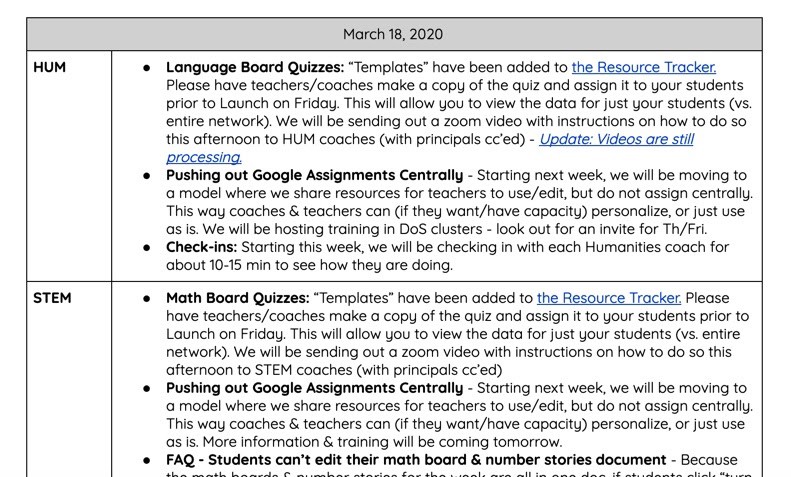
One Week In: Rocketship’s Reflections on Remote Learning
By Julie Kennedy and Kylie Alsofrom
*This article originally appeared on Charter School Growth Fund on March 27, 2020
Rocketship Public Schools, a high-performing public charter network with elementary schools in California, Nashville, Milwaukee, and DC (and soon Texas), launched distance learning at most schools on Tuesday, March 17. With a short turnaround and only one day of teacher training, distance learning is now available for all 9,634 students.
(For more on launching distance learning: check out “First Steps into Virtual Instruction: Advice from a Pioneer” which outlines effective strategies to get all students online and learning quickly.)
After one week, what has Rocketship learned and how have they responded?
They created new processes for monitoring student engagement.
According to Kylie Alsofrom, Rocketship’s Director of Schools and National Professional Development who is helping to lead their response to school closure, Rocketship tracks multiple touch points across a week to measure student engagement. Multiple measures feels important given that students’ and families’ situations are continuously evolving.
First, engagement is measured based on students’ progress towards weekly goals on Rocketship’s online learning programs. These programs were in place prior to closure and students were previously given time in the school day to work on these. If students are logging in and making progress each day, Rocketship knows they are engaging with distance learning.
Second, the team monitors student engagement and participation in daily Zoom classes and/or daily work completion on Google Classroom and EdCite.Schools monitor engagement both to ensure students are participating in the learning and also to check for wellness and mental health.
They shifted to some scheduled Zoom classes.
Rocketship’s original plan had all instruction happening asynchronously: teachers were recording videos and posting those online; students would watch and complete work on their own.
Throughout the first week, however, teachers started independently moving to scheduled, “live” Zoom classes. They still record and post lessons — but they also invite students to attend. This shift happened for two reasons:
Teachers were eager to build opportunities for students to engage in academics with their peers.
Families expressed appreciation for a consistent schedule for students (and the flexibility to watch online afterwards if it doesn’t work for a specific day).
They run daily principal check-ins.
Given that the situation is so dynamic, Rocketship principals meet daily to share bright spots, collaborate and problem solve. This allowed for issues and feedback to quickly filter back up to the rest of the network team.
This also created opportunities for the principals and the network team to learn and grow together as the schools identified the most innovative ways to use the technology and platforms in real time.
School leaders continue to hold virtual “cafecitos” (coffees) with parents.
Prior to school closure, Rocketship principals hosted regular (at least monthly) in-person Cafecitos as an opportunity to connect with parents and families. In the past week, principals shifted to hold those online and used it as an opportunity to check in with families and gather valuable feedback on the family experience with the distance learning plan.
They established a “Care Corps.”
One week in, the Rocketship team shifted their meal distribution to twice a week (families can pick up multiple days’ worth of food). This shift freed up operations staff and mental health providers at each school to be part of the newly formed “Care Corps,” which is tasked with supporting families as varying needs arise in this shifting situation.
They launched daily wellness check-ins.
The Rocketship team is about to launch a simple, five-question daily wellness “check-in” survey for families to ensure they have timely and concrete data to direct the work of the CareCorps.
Families complete a Google Form with the five daily questions that are shown below:
1. My student completed all of their assignments. (Y/N)
2. Rate your distance learning experience yesterday. (1–5)
3. Do you feel safe at home?
4. I would like more information or resources for: food, shelter, financial resources, health care, employment, nothing at this time — I have everything I need.
5. Please let us know if you have any needs or anything we should be aware of.
Responses are then matched to student information and are filtered to the appropriate campus. From there, a team captain from each campus follows up with families needing resources. The captain also partners with teachers to follow up with families that did not respond in their daily check-in calls.
They gave space for teacher creativity to thrive.
The network content team supplies teachers with lesson resources but the teachers’s creativity and authenticity really took off with the creation of the videos and the many ways teachers were celebrating students on their school Facebook pages.
As a result, teachers have:
-Wow-ed the network team with their tech-savvy and creativity; and
-Produced high-quality, clear lessons that they’ve rehearsed and filmed multiple times (an example is shown below).
The preparation for these lessons mirrors some of the strongest intellectual prep practices from pre-closure.
Teachers report finding so much joy in finding ways to keep kids smiling by posting funny celebrations, shout-out videos, cooking lessons, dance clubs and more.
They streamlined communication.
Knowing the amount of information likely to be flowing in this dynamic situation, the Rocketship team prioritizes streamlining teacher and principal-facing communication.
As an example, Kylie — the director of schools on the task force — sends a daily email to all school leaders, pulling communication from various functional teams. Also,the network content teams update a Google Document daily with any resources, changes, or responses to feedback that are specific to a content area.

They are sharing great teaching videos to communicate and clarify vision for effective teaching.
Teachers are already recording themselves teaching — this leads to a natural opportunity for:
- Network academic team leaders to film their own example lessons and share;
- Teachers to share lessons that are working with each other; and
- Leaders to share videos of effective practices to communicate and clarify a vision for great teaching in this new setting.
These shareable teaching videos have also created opportunities for shout-outs across the network and opportunities to continue celebrating ingenuity and raising morale during an especially challenging time.
We’re thrilled that Rocketship is also preparing to share strong examples of teaching publicly soon! We will update with a link to that content when available.
In the meantime, here are two videos that capture their vision. The first video is from day #2 and the second video is from a few days later. In younger grades, Rocketship is using Facebook videos. Parents respond in the comments with pictures of student work. In the second video, the teacher calls out this practice at the end!
And they are actively capturing practices Rocketship will keep forever.
As they’re building, the Rocketship team also is keeping track of practices, ideas, and solutions that also will be effective whenever they return to “brick and mortar” campuses.
Things like online homework and high-quality film of mini-lessons are just the start of how some of this work will live beyond this crisis — and hopefully make schools even better in the long-run.
See a video with highlights from Rocketship’s first week of distance learning here.
Other COVID-19 Resources from Charter School Growth Fund:
“When Days Become Weeks: Building Blocks for Strong Remote Learning”
“Approaches to Instruction During School Closure”
“First Steps Into Virtual Instruction: Advice from a Pioneer”
To create a virtual community of practice, school and network leaders can upload and peruse high-quality resources here. While CSGF cannot attest to the accuracy or quality of all of these resources, we hope that this will be a helpful place to crowdsource resources during a dynamic situation.
Published on March 31, 2020
Read more stories about: Distance Learning.


